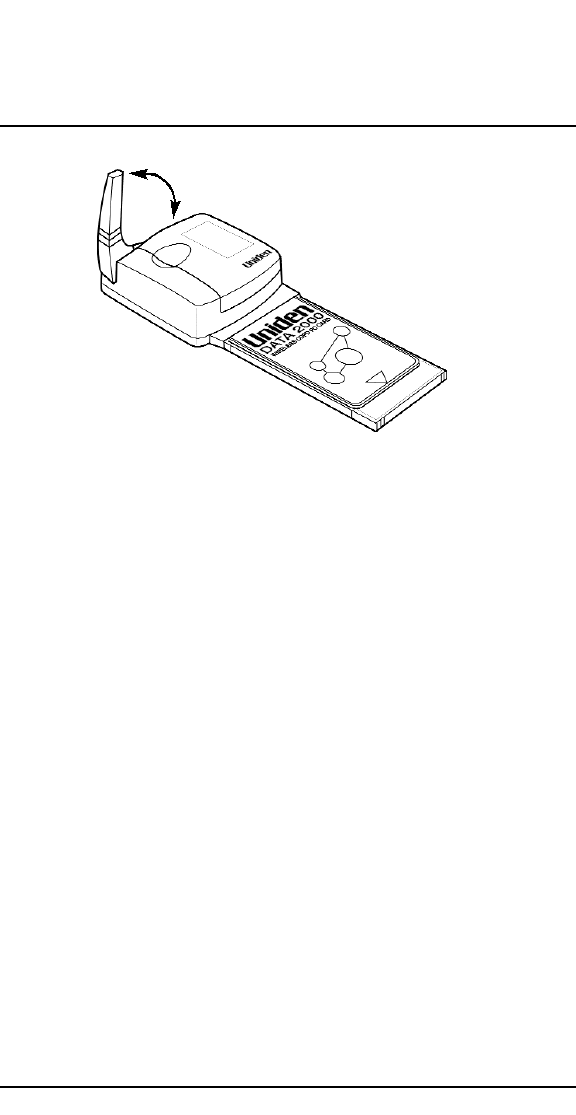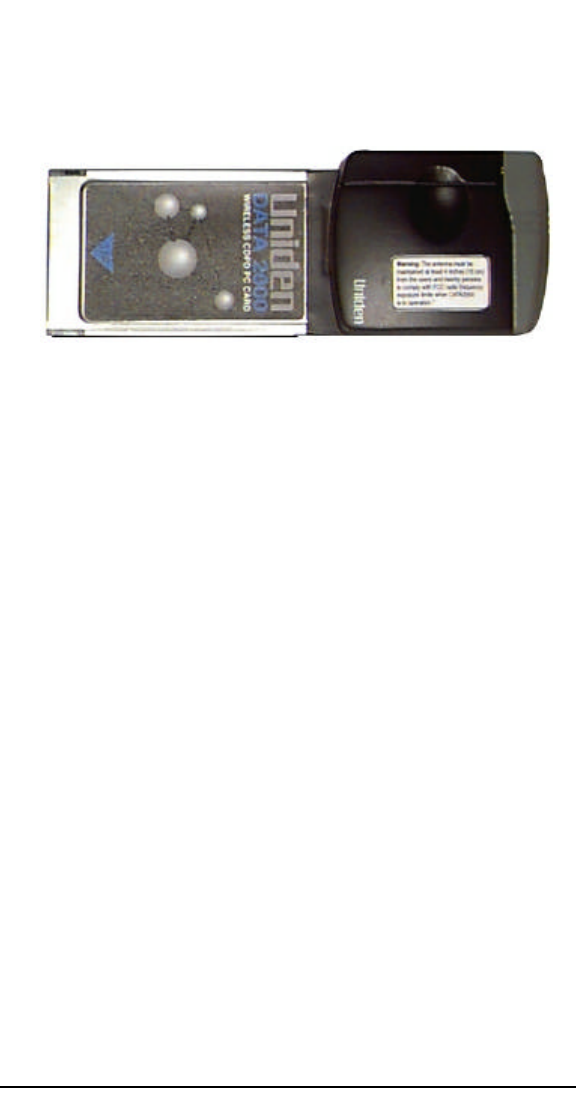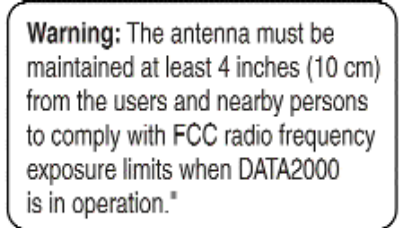Uniden America UH302 Wireless Cellular Digital Packet Data (CDPD) PC Ca User Manual Corrected Chapter One
Uniden America Corporation Wireless Cellular Digital Packet Data (CDPD) PC Ca Corrected Chapter One
Contents
- 1. Users Manual
- 2. Additional Information
- 3. Corrected Chapter One
Corrected Chapter One

Caution - Before operating this device, be sure to place the
antenna in the vertical position. This offers the best per-
formance of your modem, and, at the same time, reduces
the risk of possible exposure to electromagnetic radiation
emanating from the antenna.
The antenna must be maintained at least 4 inches (or 10
cm) from users and nearby persons to comply with FCC
radiofrequency exposure limits (and to reduce the risk of
RF radiation) when the DATA 2000 is in operation."
1-1What is the Uniden Data 2000?
The Uniden Data 2000 is a wireless CDPD PC Card which enables most
vendors’ laptops, handheld computers, and Personal Digital Assistants
with Type II PC Card slots to communicate with host-based applications
such as web servers, intranet servers, databases, dispatch systems, and
other host computer systems. The Uniden Data 2000 uses the Internet
suite of protocols running over the CDPD (Cellular Digital Packet Data)
system. The product is fully Windows compatible, supporting Windows
95, Windows NT, and Windows CE, and provides a Graphical User
Interface (GUI) which offers the user simplified access to operational
status and statistics, as well as the ability to configure, control, and moni-
tor the performance of the device. The Uniden Data 2000’s compact size
makes it an easily portable communications tool that can be stored con-
veniently in a briefcase or purse when not in use.
▲Uniden Data 2000 Wireless CDPD PC Card
Uniden Data 2000 Introduction
1
Uniden Data 2000 Operation & Programming Guide1-1
RAISE ANTENNA

▲Uniden Data 2000 Wireless CDPD PC Card
1-2What is CDPD?
CDPD or Cellular Digital Packet Data is a wireless, public access, pack-
et data standard designed to operate over existing analog cellular
phone systems. Since it is designed to use existing cellular phone sys-
tems, CDPD provides a large coverage area, low service pricing, and
fast transaction execution. CDPD’s primary benefit is quick, inexpen-
sive, and efficient transmission of data packets over the existing cellu-
lar network. Additional benefits include built-in encryption for security
(where applicable); a billing structure which charges for message size
rather than on-line time (depending on individual service provider’s
service plans); forward error correction methods that reduce the effects
of noise and interference on the airlink; and availability.
1.3What is the PCMCIA Standard for PC Cards?
Over the past several years, mobile computers have experienced
explosive growth. While prices have fallen sharply, features are becom-
ing more advanced and reliability has been greatly improved. One of
the most notable features of today’s mobile computers is the PC Card
slot. Over the last four years, the personal computer industry has rapid-
ly adopted the PC Card slot feature, and today nearly 75 percent of lap-
tops include a PC Card slot. This has been the driving force in the
innovation and development of PC Card technology.
In 1989, an international standards body and trade association was
founded, called the PCMCIA (Personal Computer Memory Card
International Association.). This organization was founded in order to
establish standards for Integrated Circuit cards and to promote inter-
changeability among mobile computers where ruggedness, low power,
and small size are critical.
Even though PCMCIA is a rather young technology, it has been quickly
adopted by every major personal computer manufacturer in the world.
Since it’s inception, PCMCIA has published a PC Card Standard which
contains all of the physical, electrical and software specifications for
PC Card technology. This standard is in a constant state of improve-
ment by the PCMCIA technical committee.
1-2

1.4Product Highlights
●Compatible with most vendors’ laptops, handheld computers
and Personal Digital Assistants (PDAs) with PCMCIA Type II
PC Card slots.
●Windows compatible (Windows 95, Windows NT, and
Windows CE.)
●Graphical User Interface (GUI) provides simplified access to
operational status and statistics, and allows the user to config-
ure, control, and monitor the performance of the device.
●AT command interface allows the user to query status and sta-
tistics, change operational modes, and configure and control
the device.
●External antenna connector allows a high gain antenna to be
substituted for maximum performance.
●Full Duplex operation with CDPD System Specification
Version 1.1.
●Data transfer via SLIP or PPP to a connected host, using the
PCMCIA interface.
●Embedded TCP/UDP/IP stack from which an embedded
application can achieve data transfer capability to the CDPD
network.
●Embedded network connectivity application, for testing end-
to-end connectivity.
●Maximum of 10 unicast Network Equipment Identifiers (NEIs)
which can be stored and activated one at a time.
●Onboard battery for operation independent of host.
●External power option for desktop use.
▲Uniden Data 2000 Wireless CDPD PC Card
Uniden Data 2000 Operation & Programming Guide1-3

▲Uniden Data 2000 Wireless CDPD PC Card
1.5Package Contents
●Uniden Data 2000 Wireless CDPD PC Card:The physical
module containing all of the electronic and other hardware
elements. (Includes the battery compartment, antenna and
PCMCIA interface connector.) The PC Board is protected by a
clam shell structure made from a 2-piece plastic sub-frame,
molded together with a stamped stainless steel cover.
●Installation Diskette:**need info
●Support Utilities Diskette: **need info
●Uniden Data 2000 Operation and Programming Guide
1.6Optional Accessories
●NiCd battery pack
●NiCd battery charger
●Antenna adapter (To allow use of high gain antenna.)
1-4
